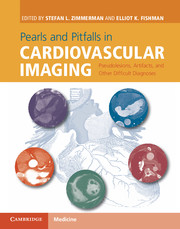 Pearls and Pitfalls in Cardiovascular Imaging
Pearls and Pitfalls in Cardiovascular Imaging from Section 10 - Peripheral vascular
Published online by Cambridge University Press: 05 June 2015
Imaging description
Popliteal artery entrapment is a developmental abnormality that results in compression of the popliteal artery due to abnormal relationships between the vessel and adjacent soft tissues within the popliteal fossa. Several types of developmental abnormalities that may result in entrapment have been identified. In most cases, the popliteal artery is medially displaced. In some cases, this is due to an anomalous course of the vessel, which can wrap around the medial head of the gastrocnemius muscle. In other patients, the artery is deviated medially by anomalous muscular or fibrous bands or anomalous lateral insertion of the medial head of the gastrocnemius muscle. Finally, in some patients there are no anomalous structures but the artery is compressed by hypertrophied gastrocnemius muscles.
Conventional angiography in neutral, dorsi- and plantar flex maneuvers is the traditional gold standard for the diagnosis of popliteal entrapment as it can identify the site of arterial injury. However, it is not commonly used due to its invasiveness and inability to delineate surrounding anatomy. Color Doppler sonography demonstrates popliteal artery narrowing, changes in color flow, or increased peak systolic velocity on flexion maneuvers but may have a significant false positive rate.
CT angiography with three separate intravenous injections in neutral, dorsi- and plantar flexion along with maximum intensity projection and volume-rendered images provide excellent contrast and spatial resolution of the surrounding abnormalities as well as the presence of occlusion and collateral formation.
MR imaging and MR angiography with gadolinium is used to evaluate the anatomy of the popliteal fossa and the presence of any vascular compromise during compression maneuvers with superior capability of demonstrating surrounding soft tissue abnormality compared to CTA (Figure 86.1). Although MRI is comparable to conventional angiography, its main limitation is the underestimation of < 50% narrowing.
Importance
Popliteal artery entrapment is an uncommon clinical syndrome seen in young adults, causing ischemic symptoms in the lower extremities. It occurs as a result of compression of the popliteal artery due to abnormal development resulting in abnormal anatomic relationship between the vessel and surrounding musculoskeletal structures.
To save this book to your Kindle, first ensure [email protected] is added to your Approved Personal Document E-mail List under your Personal Document Settings on the Manage Your Content and Devices page of your Amazon account. Then enter the ‘name’ part of your Kindle email address below. Find out more about saving to your Kindle.
Note you can select to save to either the @free.kindle.com or @kindle.com variations. ‘@free.kindle.com’ emails are free but can only be saved to your device when it is connected to wi-fi. ‘@kindle.com’ emails can be delivered even when you are not connected to wi-fi, but note that service fees apply.
Find out more about the Kindle Personal Document Service.
To save content items to your account, please confirm that you agree to abide by our usage policies. If this is the first time you use this feature, you will be asked to authorise Cambridge Core to connect with your account. Find out more about saving content to Dropbox.
To save content items to your account, please confirm that you agree to abide by our usage policies. If this is the first time you use this feature, you will be asked to authorise Cambridge Core to connect with your account. Find out more about saving content to Google Drive.